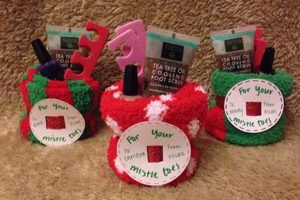A personalized collection of gift cards, arranged within a custom-designed booklet, provides a tailored gifting experience. This handcrafted approach elevates the standard gift card, transforming it into a more meaningful and memorable present. For instance, a travel-themed booklet could contain gift cards for airlines, hotels, and restaurants, creating a curated experience for the recipient.
The significance of a carefully assembled gift card compilation lies in its personalization and thoughtfulness. Rather than a generic offering, it demonstrates an understanding of the recipient’s interests and preferences. The construction of these custom collections offers an alternative to mass-produced presents, aligning with a broader movement toward mindful consumption and unique, handcrafted items. Historically, personalized gifts have held a special place, signifying a deeper connection between giver and receiver.
The following sections will explore the materials needed for this project, different design approaches, and tips for personalization, ensuring the creation of a truly unique and appreciated gift.
Crafting a Superior Gift Card Compilation
Maximizing the impact of a personalized gift card booklet requires careful planning and execution. The following tips provide guidance for producing a high-quality and memorable gift.
Tip 1: Select Appropriate Gift Cards: Align gift card choices with the recipient’s specific interests and needs. Avoid generic cards; instead, focus on retailers or experiences known to be enjoyed.
Tip 2: Establish a Cohesive Theme: Develop a unifying theme to enhance the presentation. This could be based on hobbies, travel aspirations, or seasonal events. For example, a “Home Improvement” booklet could contain cards for hardware stores, paint suppliers, and home dcor retailers.
Tip 3: Employ High-Quality Materials: Opt for sturdy cardstock or heavyweight paper for the booklet’s pages. This ensures durability and provides a premium feel. Consider using textured or patterned paper to add visual interest.
Tip 4: Incorporate Personalized Embellishments: Add personal touches, such as handwritten notes, photographs, or small mementos related to the recipient or the theme. These additions enhance the emotional value of the gift.
Tip 5: Ensure Secure Gift Card Attachment: Use photo corners, double-sided tape, or custom-designed pockets to securely hold the gift cards within the booklet. Ensure that the cards are easily removable without damaging the booklet.
Tip 6: Pay Attention to Layout and Design: Plan the layout of each page, considering the placement of gift cards, text, and embellishments. Maintain a balanced and visually appealing design.
Tip 7: Proofread and Edit Carefully: Thoroughly proofread all text for errors in grammar and spelling. A polished presentation enhances the overall impression of the gift.
By implementing these strategies, the resulting gift card booklet will transcend a mere collection of cards, becoming a treasured keepsake.
The next section will delve into creative presentation ideas and advanced techniques for constructing exceptional gift card compilations.
1. Personalization
Personalization forms the cornerstone of a handcrafted gift card booklet, transforming a generic offering into a thoughtful and meaningful present. The following facets illuminate how personalization enhances the impact and value of these bespoke creations.
- Recipient-Focused Selection
The core of personalization involves selecting gift cards that directly align with the recipient’s interests, hobbies, and needs. This extends beyond simply knowing a person’s general preferences; it requires a nuanced understanding of their specific desires and aspirations. For example, an avid gardener might appreciate gift cards to local nurseries or specialized gardening supply stores, reflecting a keen awareness of their passion.
- Thematic Cohesion
Personalization manifests through the development of a unified theme that ties together the gift card selections and the booklet’s design elements. This thematic approach creates a cohesive and immersive experience for the recipient. An example includes a “Spa Day” booklet containing cards for massage services, aromatherapy products, and relaxation experiences, all contributing to a singular, pampering concept.
- Bespoke Design Elements
The design of the booklet itself offers significant opportunities for personalization. Incorporating elements such as custom artwork, handwritten notes, photographs, or inside jokes creates a truly unique and memorable keepsake. These touches elevate the gift beyond its monetary value, transforming it into a personal artifact that reflects the relationship between giver and receiver. For instance, including photos from shared experiences or inside jokes reinforces the personal connection.
- Expressive Embellishments
Adding thoughtful embellishments further enhances the personal touch. This could involve including small, related items alongside the gift cards, such as packets of gourmet tea with a tea shop gift card or travel-sized toiletries with a hotel gift card. These additions demonstrate an extra level of care and consideration, solidifying the gift’s personalized nature.
By integrating these facets of personalization, a handcrafted gift card booklet becomes more than just a collection of gift cards; it becomes a tangible expression of thoughtfulness and a lasting reminder of the giver’s care and attention.
2. Customization
Customization is an intrinsic element of the “diy gift card book” concept, directly influencing its perceived value and utility. The ability to tailor the booklet’s contents and design significantly enhances its appeal, transforming a potentially impersonal gift into a carefully considered offering. The degree of customization directly correlates with the recipient’s appreciation, as it demonstrates a profound understanding of their individual preferences and needs. For example, a generic gift card lacks the intentionality of a custom-designed booklet featuring gift cards to specific restaurants known to be favored by the recipient, coupled with personal notes and relevant imagery.
Furthermore, customization extends beyond the selection of gift cards. The physical design of the booklet itself offers extensive opportunities for personalized expression. Materials, colors, and layout can be adapted to reflect the recipient’s personal style or to complement a chosen theme. Handcrafted elements, such as custom artwork or handwritten messages, amplify the sentiment and contribute to a more meaningful presentation. In contrast, a commercially produced gift card lacks this inherent capacity for personalized expression, limiting its potential emotional impact. The flexibility inherent in the “diy” approach to gift card presentation fosters creativity and allows for the development of truly unique and memorable gifts.
In summary, customization serves as a critical differentiating factor, elevating a simple gift card into a personalized and thoughtful gesture. The effort invested in tailoring the contents and design to the recipient’s individual preferences demonstrates a level of care and attention that surpasses the offering of a standard, mass-produced gift. The success of a “diy gift card book” hinges on the degree to which it reflects the recipient’s personality and preferences, making customization an indispensable component of its creation.
3. Creativity
Creativity is a foundational element in the successful execution of a “diy gift card book.” It transcends mere aesthetics, influencing both the functional design and the emotional impact of the final product. The level of creative input directly affects the perceived value and memorability of the gift.
- Innovative Design Solutions
Creativity drives the development of unique and functional designs for holding and presenting gift cards. This includes devising novel ways to secure the cards, incorporating interactive elements, and utilizing unexpected materials. For example, a book designed as a miniature suitcase, complete with tiny luggage tags for each gift card representing a travel destination, demonstrates a high degree of creative design. Such innovation elevates the gift beyond a simple collection of cards.
- Thematic Conceptualization
The selection and integration of a unifying theme demand significant creative input. A well-developed theme enhances the coherence and impact of the gift. For example, a “Movie Night” themed booklet might incorporate film-related graphics, ticket stub replicas, and gift cards for movie theaters, streaming services, and snack vendors. The theme serves as a cohesive narrative, enhancing the overall gifting experience.
- Personalized Artistic Expression
Creativity allows for the incorporation of personalized artistic elements, transforming the booklet into a bespoke piece of art. This could involve hand-drawn illustrations, original poetry, or custom calligraphy. For example, a booklet featuring watercolor paintings depicting scenes relevant to the recipient’s interests or personalized quotes adds a layer of emotional depth and artistic value. Such expression transcends the purely functional aspect of the gift.
- Resourceful Material Utilization
Creative resourcefulness extends to the selection and utilization of materials. This includes repurposing existing items, combining unexpected textures, and exploring unconventional crafting techniques. For example, using reclaimed book covers, vintage maps, or recycled fabrics to construct the booklet demonstrates a commitment to both creativity and sustainability. The inventive use of materials adds a unique character to the finished product.
In conclusion, creativity permeates every stage of the “diy gift card book” creation process, from initial design conception to final material selection. It is the driving force behind transforming a simple collection of gift cards into a personalized and memorable gift, reflecting a genuine investment of time, effort, and imagination.
4. Practicality
Practicality serves as a foundational element of the “diy gift card book,” directly influencing its effectiveness and lasting value. The selection of gift cards, inherently practical in their function, forms the core of this handcrafted present. This approach enables the recipient to acquire goods or services they genuinely desire, thereby circumventing the potential for unwanted or duplicated gifts. This tailored selection transforms a potentially impersonal gesture into a thoughtful and pragmatic offering, addressing a specific need or preference. For instance, a new homeowner might appreciate gift cards to home improvement stores, furnishing them with the means to enhance their living space. The practical implications of this approach lie in its direct applicability to the recipient’s immediate needs.
The practical aspects extend beyond the selection of gift cards to encompass the design and construction of the booklet itself. A well-designed booklet ensures easy access to the gift cards and protects them from damage. Durable materials and secure attachment methods contribute to the longevity of the gift, extending its practical lifespan. Consider a traveler receiving a booklet containing gift cards for various airlines and hotels. A robust, travel-friendly design safeguards these valuable assets during transit, enhancing the overall user experience. The inherent practicality of the booklet’s design contributes to its long-term usability and appreciation.
In summary, the connection between practicality and the “diy gift card book” is undeniable. The careful selection of useful gift cards, combined with a functional and durable design, transforms a potential novelty item into a genuinely valuable and appreciated present. The success of this approach hinges on a thorough understanding of the recipient’s needs and a commitment to creating a practical and enduring gift. The practical considerations in its design and contents ultimately determine its long-term usefulness and perceived value.
5. Presentation
The presentation of a handcrafted gift card compilation significantly impacts its perceived value and emotional resonance. While the underlying function of the “diy gift card book” revolves around the utility of the enclosed cards, a carefully considered presentation elevates the gift beyond a mere exchange of monetary value. The visual appeal, tactile experience, and overall design contribute to the recipient’s initial impression and subsequent appreciation. A poorly presented compilation, regardless of the value of the gift cards contained within, may diminish the perceived thoughtfulness of the gesture. Conversely, an exquisitely presented compilation amplifies the perceived value and conveys a heightened level of care and consideration. For example, a gift card collection designed around a travel theme, housed within a miniature passport-styled booklet with personalized stamps and travel-related imagery, conveys a more profound sense of personalization and intent than a collection of the same gift cards simply bundled together.
The presentation encompasses various elements, including the choice of materials, the overall design aesthetic, and the inclusion of supplementary embellishments. Selecting high-quality cardstock, incorporating thematic design elements, and adding personal touches such as handwritten notes or relevant mementos contribute to a more impactful presentation. The manner in which the gift cards are secured within the booklet also influences the overall presentation. Using photo corners, custom-designed pockets, or decorative ribbons to attach the cards enhances the visual appeal and reinforces the sense of craftsmanship. Furthermore, the packaging of the completed booklet contributes to the overall impression. A thoughtfully chosen envelope, box, or wrapping paper adds an additional layer of sophistication and elevates the presentation.
In essence, the presentation is not merely an aesthetic consideration but an integral component of the “diy gift card book” concept. A well-executed presentation demonstrates a commitment to detail and reinforces the thoughtfulness behind the gift. By investing time and effort in the presentation, the giver transforms a functional gift into a memorable and cherished keepsake. The challenges associated with presentation lie in achieving a balance between aesthetic appeal and practical functionality, ensuring that the presentation enhances, rather than detracts from, the overall usability and enjoyment of the gift.
Frequently Asked Questions
This section addresses common inquiries regarding the creation and implementation of handcrafted gift card compilations.
Question 1: What are the fundamental advantages of a “diy gift card book” compared to single gift cards?
A handcrafted gift card collection provides a personalized and thematic gifting experience, allowing for greater customization and a more thoughtful presentation than individual, commercially available gift cards. The recipient benefits from a curated selection of options aligned with their specific interests.
Question 2: What is the optimal method for securing gift cards within the booklet without causing damage?
Photo corners, archival-quality double-sided tape, or custom-designed pockets offer secure and non-destructive attachment methods. Avoid adhesives that may react with or damage the gift cards’ surfaces.
Question 3: What types of materials are best suited for constructing a durable and visually appealing “diy gift card book?”
Heavyweight cardstock, patterned paper, and repurposed book covers provide a sturdy foundation. Embellishments such as ribbons, photographs, and handwritten notes enhance the aesthetic appeal.
Question 4: How can a cohesive theme be established throughout the “diy gift card book?”
Themes should be based on the recipient’s interests, hobbies, or upcoming events. The selected gift cards, design elements, and embellishments should consistently reflect the chosen theme to create a unified presentation.
Question 5: What strategies can be employed to personalize a “diy gift card book” for recipients with diverse preferences?
Thoroughly assess the recipient’s interests and tailor the gift card selections accordingly. Incorporate personal anecdotes, inside jokes, and shared memories into the design to create a unique and meaningful gift.
Question 6: What are the potential pitfalls to avoid when constructing a “diy gift card book?”
Overuse of adhesives, failure to align gift card selections with the recipient’s interests, and neglecting the overall aesthetic coherence can detract from the gift’s perceived value. Careful planning and execution are essential to avoid these issues.
The insights provided above aim to ensure the successful creation of a personalized and well-received gift card compilation.
The subsequent section delves into advanced design techniques and creative embellishment strategies.
DIY Gift Card Book
The preceding exploration of “diy gift card book” has elucidated its core components: personalization, customization, creativity, practicality, and presentation. These elements, when harmoniously integrated, transform a simple assortment of gift cards into a bespoke and cherished present. The deviation from mass-produced items underscores a commitment to thoughtful gifting, recognizing the unique preferences of the recipient.
The enduring significance of handcrafted gifts lies in their capacity to convey a level of care and attention that surpasses commercially available alternatives. By embracing the principles outlined herein, individuals can elevate the act of gift-giving, fostering stronger connections and creating lasting memories. The future likely holds further innovation in crafting techniques and personalization strategies, ensuring the continued relevance of this meaningful practice. Consider the principles discussed to enhance future gifting endeavors.




![Unique Gift: Boyfriend DIY Ideas [Crafted With Love] The DIY Hub: Creative Crafts, Repairs & Life Hacks Unique Gift: Boyfriend DIY Ideas [Crafted With Love] | The DIY Hub: Creative Crafts, Repairs & Life Hacks](https://craftingdiycenter.com/wp-content/uploads/2025/07/th-3113-300x200.jpg)


